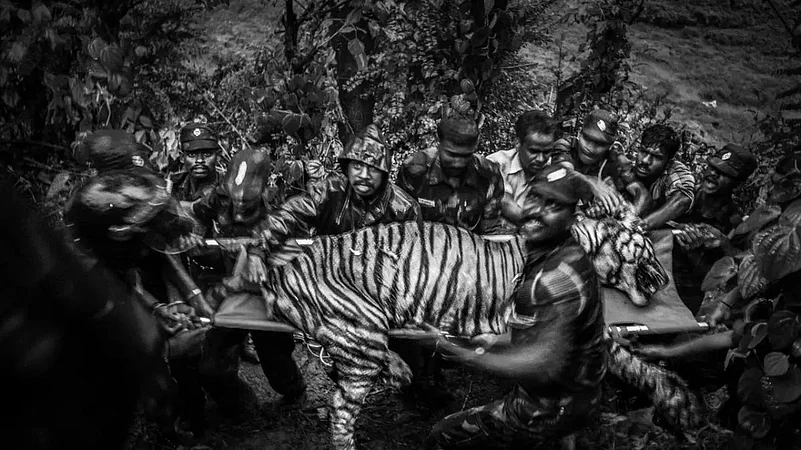Senthil Kumaran, an independent visual storyteller, has been covering the human-tiger conflict for the past 10 years. Kumaran has recently won a major award. The photographer speaks to Outlook regarding tiger conservation and the impact of environmental degradation and his journey as a wildlife photographer in India.
You have won the Prestigious World Press Photo 2022 award in the Long-Term Story Category (Asia Region). Could you share your journey as a photographer with us?
I was born and brought up in a small town. When I entered photography some twenty years ago, there were no professionals or platforms to teach documentary photography to young photographers like me. We learned everything by ourselves. It was only in 2002 when I saw the World Press Photo journal. In my initial days, World Press photos and award-winning stories significantly impacted me. Photographs in the nature story category, in particular, greatly influenced me. After that, I started capturing ecological-related documentary photos. Winning the World Press photo contest remained a 15-year dream for me, and has finally become possible today. I believe the World Press photo award is the top most recognition for a photojournalist and documentary photographer. Now, I have a huge responsibility to represent the country and ecological issues in my future work.
Advertisement
What triggered your interest in shooting man-tiger conflicts?
When I was 10 years old, I first saw the tiger on my black and white television. The majestic look of the tiger impressed me a lot and also created an interest in me to see the tiger in the wild. But even after ten years of searching in various forests, I couldn’t spot any tiger. However, my travels prompted me to become a wildlife photographer and understand nature. Several years later, I got a call from the forest department that a tiger had entered into the town and the forest department wanted to document the tiger relocation operation.
Advertisement
I had never seen a tiger since I was 10 and almost 25 years later, I got the opportunity. I went to the spot with great interest. I was shocked to see the weak and injured tiger lying on the backside of a house in a village with a huge crowd gathered around, preparing to attack the tiger. My 25 years of wait and eagerness to see the majestic tiger ended with great disappointment as the tiger died the next day because of the human-animal conflict.
This incident made me think and understand the real cause of the situation. It also drove me to connect and travel with different conservationists, forest officials and villagers to understand the human-tiger and human-elephant conflict from different dimensions.

How do you see the human-tiger conflict, given the fact that the tiger is our national animal and is factored majorly in our conservation policies?
For several centuries, both the tribals and animals have lived together in the forest. The impact of deforestation of Indian forest over the last 100 years is now showing in the 21st century. In order to save their livelihood, both animals and people have started to fight with each other for their survival.
I captured the perspectives of both sides in my photographs. I understood the problems and livelihood challenges of local communities. Generally, in human-animal conflict, the media and the general public are always in favour of the tiger. The villagers are left alone. My documentary tried to explain the problems and challenges of the impacted people, though it was centred on the tiger and ecological conservation.
Advertisement
The government has been taking many preventive efforts to address the human-animal conflict. The tiger’s population has doubled in the last 10 years. At the same time, forests have also seen a lot of destruction. Checking deforestation and finding a way to increase the forest landscape can be a way to reach a solution.
How does human-animal conflict affect the indigenous population?
The history of humanity is rooted in human-animal interactions. They have lived together. Coexistence with wild animals would seem unthinkable and impossible to common people today. Yet, the native tribes have done so for generations and continue to do so. They share their home and forest with animals. It has been possible only because of the wisdom of the tribes about behaviour of the animals acquired over generations of sharing the space with them.
Advertisement
Now, the human-animal conflict is increasing and will increase further because wildlife habitats are shrinking under pressure from humans. The reduction in forest cover is primarily attributed to the introduction of interventions such as plantations, factories, mines, roads, dams etc. in forest ecosystems. Because of the ‘human encroachment’, animals are forced to shift their habitat’s boundaries to the neighbouring areas. In many cases, the expanded area falls within the limits of tribal villages and grazing lands. The conflict starts from here.
According to a report, nearly 29 per cent of tigers lives outside of the core zone and close to 80 per cent of the elephant corridors have been affected because of the encroachments and various development activities. There has been an increase in the killing of humans and animals, and the destruction of crops by animals. In the last 5 years, nearly 2500 people have been killed by elephants and have been pushed to fight against the animals to save their cattle, farmlands and livelihood.
Advertisement
Every 72 hours, an elephant is killed because of the human-animal conflict. This creates a permanent conflict that pushes the villagers/tribals to turn against the animals to save their livelihood. This conflict may remain unsolvable without proper conservation policy and guidelines.




















